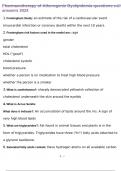Exam (elaborations)
Pharmacotherapy of Atherogenic Dyslipidemia questions with answers 2024
- Course
- Institution
Pharmacotherapy of Atherogenic Dyslipidemia questions with answers 2024 Pharmacotherapy of Atherogenic Dyslipidemia questions with answers 2024 Pharmacotherapy of Atherogenic Dyslipidemia questions with answers 2024
[Show more]



